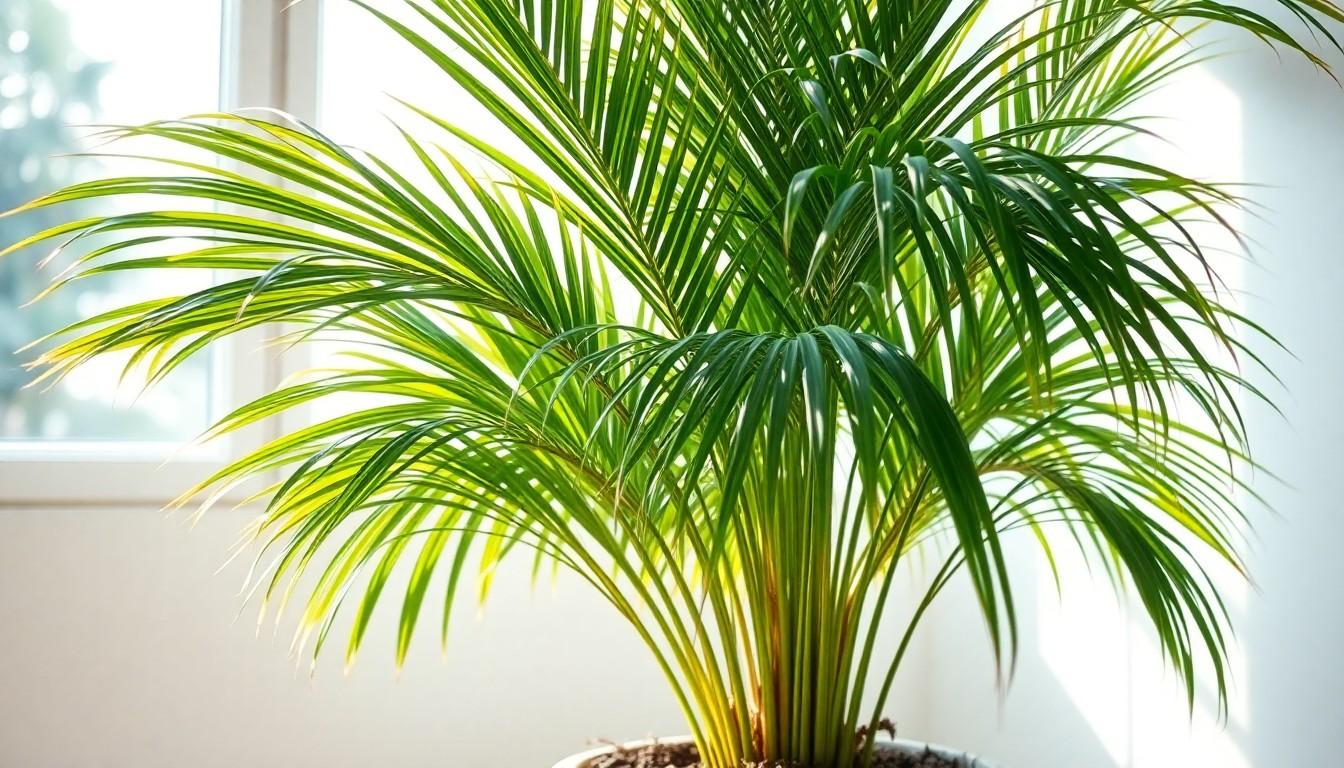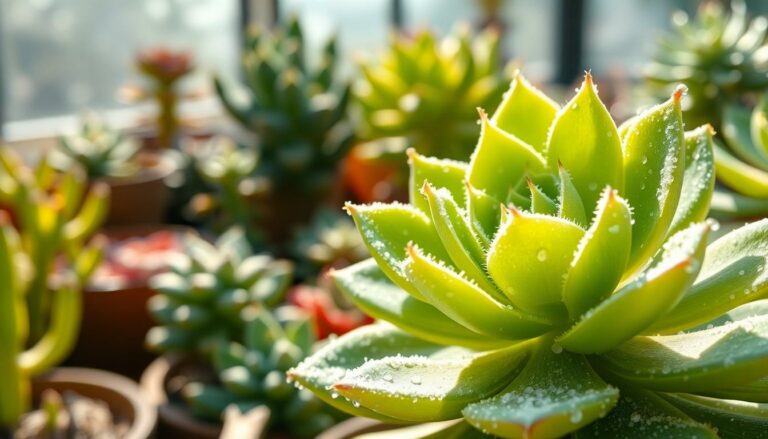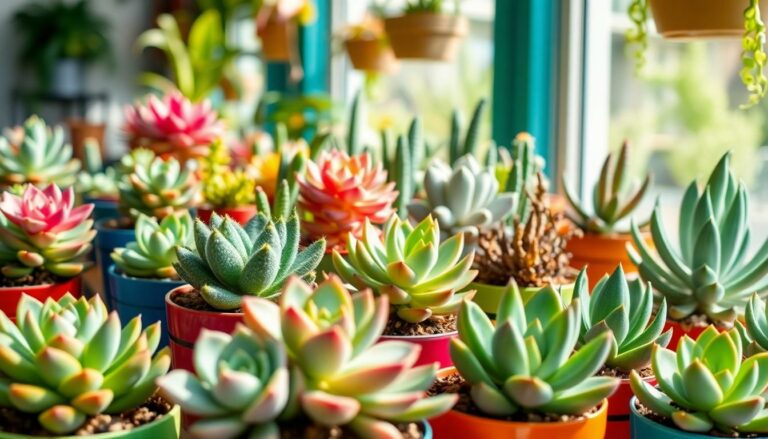Palm plants bring a touch of tropical paradise right into the living room, but keeping them happy isn’t as easy as it sounds. With their lush fronds and laid-back vibe, these green beauties might seem like they’re just chilling, but they have a few needs that could rival a diva on a bad day.
Understanding Palm Plants
Caring for palm plants involves understanding their unique characteristics. These plants thrive in various environments but require specific conditions to flourish.
Common Types of Palm Plants
Numerous palm plants are popular in home decor. The Areca palm offers a feathery appearance, making it a preferred choice for indoor spaces. The Majesty palm stands out with its elegant leaves and adaptability. The Kentia palm combines beauty with versatility, suitable for both low and bright light areas. Each type has distinct features that cater to different aesthetic preferences and care abilities.
Ideal Growing Conditions
Palm plants generally prefer warm climates and humidity. They flourish in temperatures ranging from 65°F to 75°F. Direct sunlight can damage their leaves, so bright, indirect light is ideal. Soil needs to be well-draining, allowing roots to breathe. Regular watering is essential, but overwatering can lead to root rot. Maintaining humidity levels through misting or using a pebble tray helps support healthy growth.
Watering Your Palm Plant

Caring for a palm plant involves understanding its watering needs. Proper watering is essential for maintaining a healthy plant.
Frequency of Watering
Watering frequency depends on the palm plant’s environment and season. During the growing season, typically spring and summer, watering every 1-2 weeks suffices. Soil should remain moist but not soggy. In cooler months, the plant requires less water, so adjusting the schedule to every 2-4 weeks is advisable. Those growing palms indoors may notice different conditions affecting moisture, such as lower humidity. Checking the soil moisture before watering ensures appropriate hydration levels are maintained.
Signs of Overwatering and Underwatering
Identifying signs of overwatering and underwatering ensures optimal plant health. Yellowing fronds often indicate overwatering. Root rot can occur if the soil remains excessively wet. Underwatered palm plants usually show browning tips on fronds. Leaf drop may also occur if the plant is too dry. Regularly inspecting the leaves and soil moisture helps in determining the right watering balance. Adjusting watering practices based on these observations supports the palm’s thriving condition.
Light Requirements for Palm Plants
Palm plants require specific light conditions to thrive, favoring bright, indirect light for optimal growth.
Direct vs. Indirect Light
Direct sunlight can scorch palm leaves, leading to damage. Bright, indirect light allows for balanced growth, promoting healthy foliage. The best approach involves placing palm plants near windows with filtered light or in rooms where sunlight isn’t too harsh. Varieties like the Areca palm and Kentia palm adapt well to lower light, showcasing versatility across different light conditions. Adjusting placement depending on the season helps maintain adequate light exposure.
Best Locations in Your Home
Ideal locations include living rooms, near east-facing windows, or light-filled spaces away from direct sun. Bathrooms often provide favorable humidity levels while filtering indirect light. Additionally, placing palms on shelves or tables can elevate their aesthetic while keeping them within reach of bright, indirect illumination. Patio doors also serve as excellent placements during warmer months, allowing sufficient light while shielding against direct rays. Considerations of seasonal changes in light are crucial when determining optimal locations for palm plants.
Fertilizing Palm Plants
Fertilizing palm plants is essential for promoting healthy growth and vibrant foliage. Proper nutrition supports their unique needs and enables flourishing development.
Choosing the Right Fertilizer
Select a balanced fertilizer specifically formulated for palms. Look for products with equal ratios of nitrogen, phosphorus, and potassium, such as 10-10-10 or 20-20-20. Organic options, including slow-release fertilizers, add beneficial nutrients over time. Some palm varieties, particularly those with yellowing fronds, may benefit from a high potassium feed. Always check labels to ensure the fertilizer caters to palm plant requirements, ensuring optimal growth and vitality.
Recommended Fertilization Schedule
Fertilization should occur every 4-6 weeks during the growing season, which typically spans from spring through early fall. Adjust timing based on the specific palm variety and individual plant needs. Reduce feeding frequency during the dormant winter months, when growth slows down substantially. It’s beneficial to water palms before applying fertilizer, as this helps prevent root burn. Regular inspection of the plant’s health can guide adjustments in the fertilization approach as necessary.
Pruning and Grooming Palm Plants
Pruning and grooming palm plants is essential for maintaining their health and appearance. Regular care promotes lush foliage and encourages strong growth.
Tools for Pruning
Essential tools for pruning include sharp scissors, pruning shears, and a clean cloth. Scissors work well for smaller fronds and delicate stems. Pruning shears handle thicker branches efficiently. Keep a clean cloth nearby to wipe tools, preventing the spread of diseases between plants. Consider using gloves as an extra precaution. These tools ensure a tidy appearance and optimal health for palm plants.
Techniques for Pruning Palm Plants
Appropriate techniques for pruning involve removing dead or yellowing fronds regularly. Start by cutting fronds at the base, ensuring not to damage the trunk. Consider trimming only those fronds that are significantly dehydrated or unhealthy. Another technique is to shape the palm by selectively removing fronds, which encourages a balanced growth pattern. Avoid excessive pruning, as palms thrive on their foliage for energy production. Always assess the palm’s overall health before making cuts, ensuring each action supports healthy growth.
Conclusion
Caring for palm plants requires attention and understanding of their unique needs. By providing the right light humidity and watering schedule these plants can thrive and enhance any space. Regular inspection and appropriate fertilization will support their growth while pruning helps maintain their appearance.
With the right care palm plants can be a stunning addition to home decor bringing a touch of the tropics indoors. By following these guidelines anyone can enjoy the beauty and benefits of these versatile plants for years to come.




